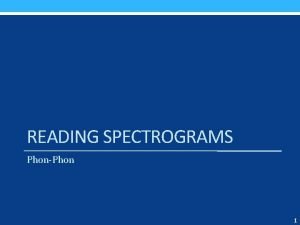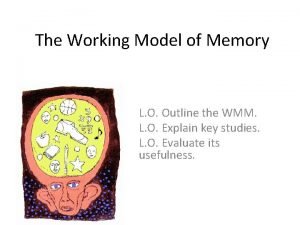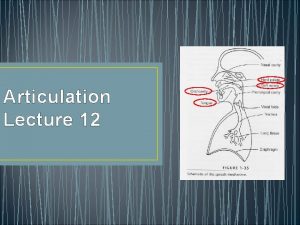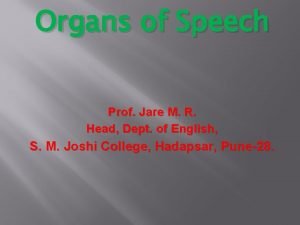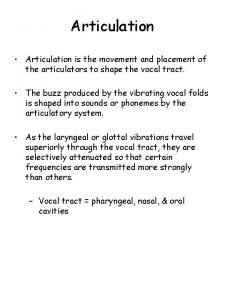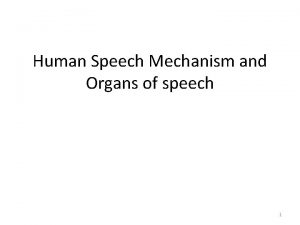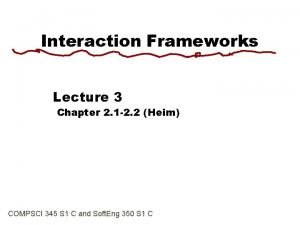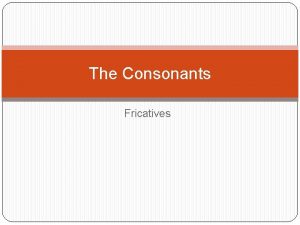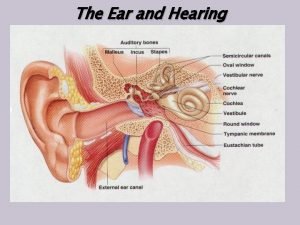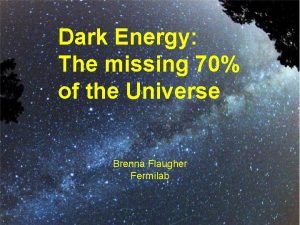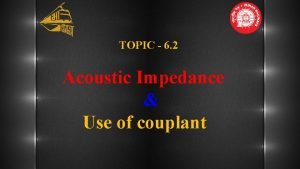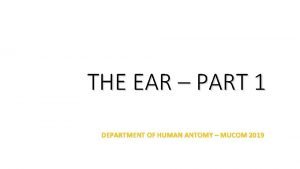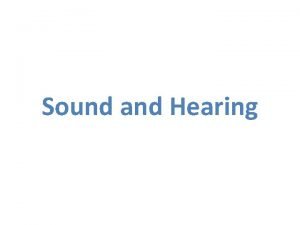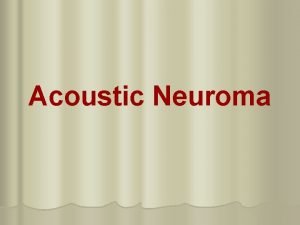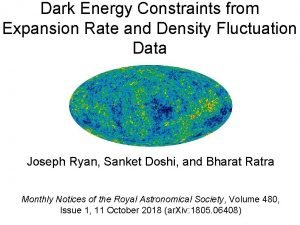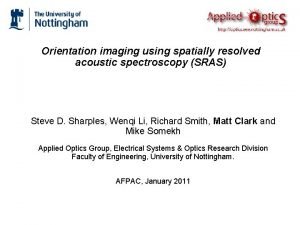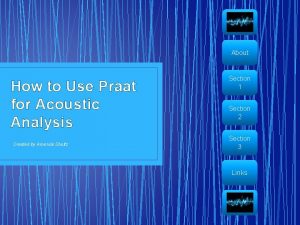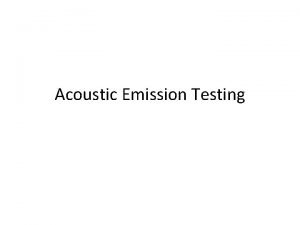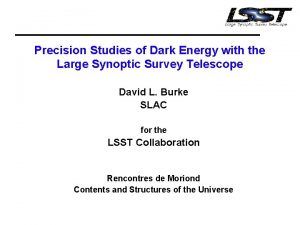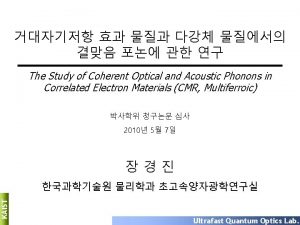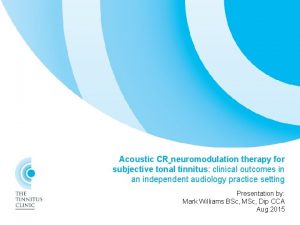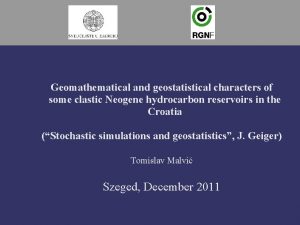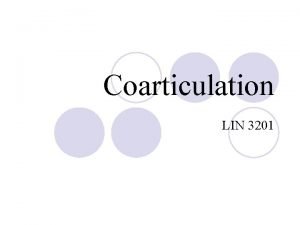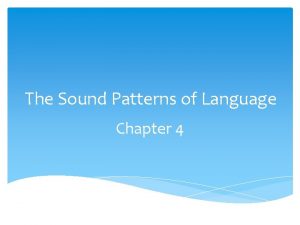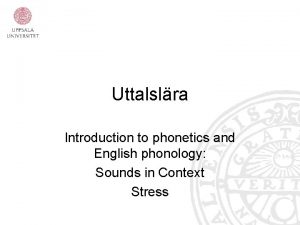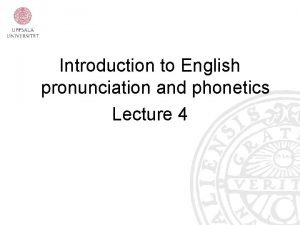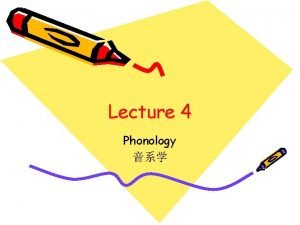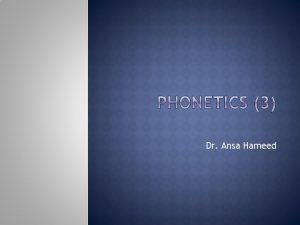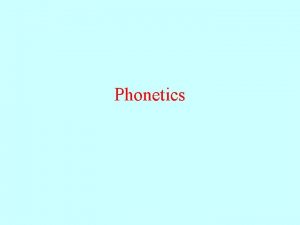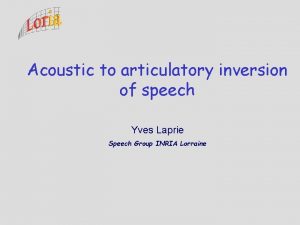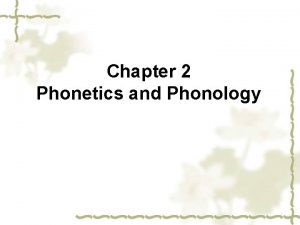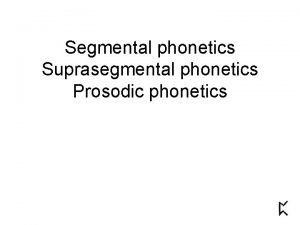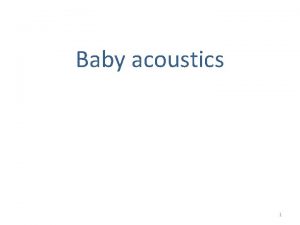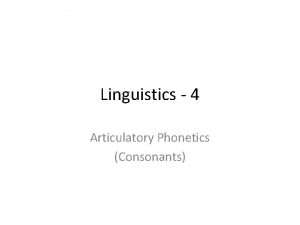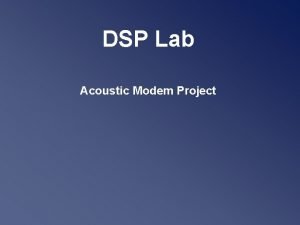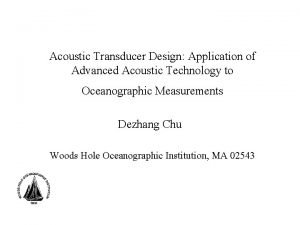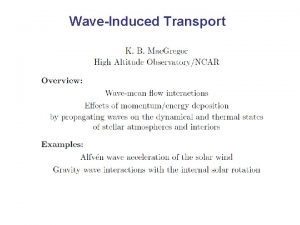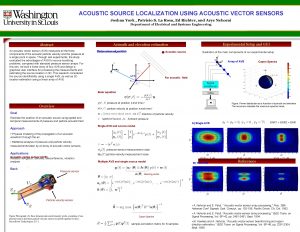3 domains of phonetics articulatory phonetics acoustic phonetics






















































- Slides: 54

3 domains of phonetics • articulatory phonetics • acoustic phonetics • auditory phonetics

Acoustics Gk. akoustos “heard, audible" akouein “to hear”

PIE *(s)keu- “notice, observe” skeu- keu. Gk akouein "to hear” akoustos "heard, audible" Lat cavere “watch out” cautio “caution” Germanic *hausjan heyra OE hieran hear WG *skauwojanan OE sceawian “watch” show skoða

3 domains of phonetics articulation acoustics audition ))))))))))))))))))

3 domains of phonetics articulation acoustics audition ))))))))))))))))))

But this guy also has an ear - and a brain )))))))))))))))))) - and a cochlea!

Good animation of cochlea: http: //www. youtube. com/user/de stinedforglory

Cochlea The Cochlea, that organ responsible for feeling sound waves and translating their oscillation into a language action potentials comprehensible to our brains, is a complex pathway of tubes and cells that segregates a complex waveform by the frequency of its oscillations. As is demonstrated by the demo simulations available here, the cochlea's core function is feeding the sound signal to the basilar membrane, an elastic organ located in the Cochlea's turns, which, by varying its mechanical properties from one end to the other, breaks sound waves into their individual frequencies. The result of this biological signal processing is that the extrema of mechanical oscillations on the membrane represent peaks in the power of the frequency spectrum. Mathematically, the mechanical oscillation of the cochlea perform a sort of Fourier Transformation. But in order to make this biological signal processing possible, the cochlea must maintain electronic potential differences between its major ventricles, the scalar vestibule and the scalar tympani, and the minor ventricle, the scalar media. This electronic battery is essential because it allows receptor cells to operate at a much faster and more precise level than would otherwise be possible. Basilar membrane simulator (shown by the cochleagram) http: //sites. google. com/site/nowwehaveyourattention/

“ah ah”

“ah ah”

0. 007760

0. 005171

“ah ah” Hz = Herz = cps = cycles per second

Frequency • The pitch of a speech sound is determined by the frequency of vocal-chord vibration. Frequency is usually measured in cycles per second (c. p. s) which are also called Hertz (Hz). • Womens' voices can go up to 400 Hz; children's voices even higher. • Average male voices range between 80 and 200 Hz

Waves In most languages, the term 'wave' originally refers to the surface movements of water (bølge, Welle, onde, volná, tonn, aalto, to give some European examples).

Waves on water are a true example of natural waveforms, but it was not until the advent of electronic technology that we discovered that a large number of waveforms occur in the physical world.

Waves Many are on too small a scale to be experienced as waves (sound- and light-waves) while others are too large (earthquakes, weather & climactic patterns, tidal movements, seasonal patterns, planetary movements). It is in fact possible to analyse a variety of natural and human processes as wave patterns: heartbeats, brain activity, population studies, the market, influenza epidemics, traffic flows (whether or not this always produces a useful analysis is another question. )

Transverse and longitudinal waves þverbylgjur og lengdarbylgjur • transverse: displacement across the direction of propogation • longitudinal: displacement along the direction of propogation

Transverse waves • to-and-fro movement (or oscillation) across the direction of propogation, either from side to side or up and down • Sea waves are transverse waves: the surface of the sea moves up and down as the waves travel over it

Transverse waves • If we use the data from this device to plot a graph showing the height of the sea above this stationary point on the sea-bed, we will get a picture in time which looks exactly the same as the spacial movement of the waves.

Longitudinal waves • to-and-fro movement in the same direction as the direction of the wave. • compression & rarifaction (þétting og þan) • travel along the line of the wave-motion see the animation at ttp: //www. glenbrook. k 12. il. us/GBSSCI/PHYS/Class/sound/eds. gif in http: //www. glenbrook. k 12. il. us/GBSSCI/PHYS/Class/sound/u 11 l 2 d. html

Longitudinal waves ttp: //www. glenbrook. k 12. il. us/GBSSCI/PHYS/Class/sound/eds. gif %

Longitudinal waves • A graph of pressure changes at any one place plotted on a time axis looks like a transverse wave pattern

Longitudinal waves • Sound waves in air are longitudinal waves, but they can be represented in this way as transverse waves x= eardrum / microphone

Sine waves • Latin sinus 'a curve' • regular frequencies simple harmonic motion – pendulum – tuning fork.

Sine waves Pure tones. When a soundwave is a pure sinewave, we hear it as a pure tone. Soundwave of pure middle A, which is 440 Hz.

Sine waves Some fairly pure examples: my tuning-fork (pitchfork? ) Praat – PK 27 Sep 2009


Sine waves Some fairly pure examples: whistling Praat – PK 27 Sep 2009

Complex waves Adding 2 sine equal waves:

Complex waves Adding: various frequencies

Recorded in Sound. Edit between 1992 -8

Recorded in Praat 27 Sep 2009

Reasons for difference: 1 phasing 2 intensities of formants Impossible to read the formants from the waveform. This problem is is overcome by Fourier analysis -- which finds the same formants although the phasing is different. This comes a few slides down

periodic and aperiodic: complex soundwaves • periodicity • not as regular as pure tones, since each 'period' is slightly different from the previous one • Human speech-sounds are not pure, but dynamic sounds: their frequency is continually changing, and so is the shape of the sound -wave.

“shoe”

“fish”

Fourier analysis • In December 1807, the French physicist and mathematician Jean Baptiste Joseph Fourier (1768 -830) read a memoir on "the propagation of heat in solids" at the French Institute. David A Keston www. astro. gla. ac. uk /~davidk/fourier. htm

Fourier analysis • The mathematics behind this method of analysis are what are known today as the Fourier Series, a branch of calculus which can be used to calculate the pure sine wave components of a complex wave. • The idea is that complex periodic waves can be broken down into a (sometimes very large) number of pure waves which when added together produce the complex wave.

Fourier analysis • In linguistic acoustics, we find that different vowels have their own typical arrangements of components, which we call formants.

Complex waves Adding 2 sine equal waves:

The basic or fundamental frequency - usually referred to as F 0, is the frequency of the greatest period, the complete repetitive cycle (= the GCD* of the frequencies of the component sine waves). This is the frequency we hear as pitch when we are working with intonation. *Greatest Common Demoninator: the largest number which divides into them all. This is true of fairly simple complex waves with only a few components. But a speech wave has thousands of component sine waves, and cycles do not repeat each other exactly. What we hear as the F 0 is practically better defined as the most prominent cyclic repetition. It's not strictly computable.

Adding waves with close frequencies

Adding waves with close frequencies

Adding 2 waves, varying the phasing of the second wave

Adding 2 waves, varying the phasing of the second wave

Adding 2 waves, varying the phasing of the second wave

Adding 2 waves, varying the phasing of the second wave

Varying the phasing of identical waves • Adding two waves phased alike

Varying the phasing of identical waves • Phasing of second wave 140°

Varying the phasing of identical waves • Phasing of second wave 170°

Varying the phasing of identical waves • phasing of 2 nd wave 180°

Aliasing

 Velar pinch spectrogram
Velar pinch spectrogram Articulatory simplification
Articulatory simplification Articulatory suppression
Articulatory suppression Articulators theatre definition
Articulators theatre definition Diagastricus
Diagastricus Bilabial phonemes
Bilabial phonemes Jare head
Jare head Faucial arches
Faucial arches Articulatory organs
Articulatory organs Interaction framework example
Interaction framework example Articulatory description
Articulatory description What is the function of the external acoustic meatus
What is the function of the external acoustic meatus Baryonic acoustic oscillations
Baryonic acoustic oscillations Baryon acoustic oscillations
Baryon acoustic oscillations Acoustic impedance of steel
Acoustic impedance of steel Ear anatomy
Ear anatomy Acoustic meatus
Acoustic meatus Acoustic stimulus is
Acoustic stimulus is Bsd nas
Bsd nas Symphysis skull
Symphysis skull Vowel quadrilateral
Vowel quadrilateral Rollover phenomenon in acoustic neuroma
Rollover phenomenon in acoustic neuroma Baryon acoustic oscillations
Baryon acoustic oscillations Spatially resolved acoustic spectroscopy
Spatially resolved acoustic spectroscopy Cranial calcification
Cranial calcification Ear-ar: indoor acoustic augmented reality on earphones
Ear-ar: indoor acoustic augmented reality on earphones Vertical angles
Vertical angles How to measure vot in praat
How to measure vot in praat Digital audio and speech
Digital audio and speech Acoustic emission testing applications
Acoustic emission testing applications Baryon acoustic oscillations
Baryon acoustic oscillations Baryon acoustic oscillations
Baryon acoustic oscillations Acoustic magazine uk
Acoustic magazine uk B&k acoustic camera
B&k acoustic camera Beamforming matlab
Beamforming matlab Optical vs acoustic phonons
Optical vs acoustic phonons Lecture hall background
Lecture hall background Acoustic era of recording technology
Acoustic era of recording technology Mail @ greenbuildingencyclopaedia.uk
Mail @ greenbuildingencyclopaedia.uk Acoustic cr
Acoustic cr Acoustic warrant officer
Acoustic warrant officer Acoustic impedance
Acoustic impedance External acoustic meatus
External acoustic meatus Coarticulation in phonetics
Coarticulation in phonetics Introducing phonetics and phonology answer key
Introducing phonetics and phonology answer key Phonetics basics
Phonetics basics Triphthong smoothing
Triphthong smoothing What is allomorph
What is allomorph Coarticulation in phonetics
Coarticulation in phonetics Phonetic peculiarities of style
Phonetic peculiarities of style Elision examples phonetics
Elision examples phonetics Assimilation in phonetics
Assimilation in phonetics Coarticulation nedir
Coarticulation nedir Language
Language Kæts
Kæts
